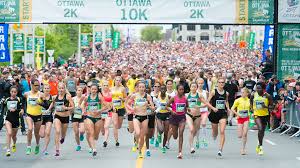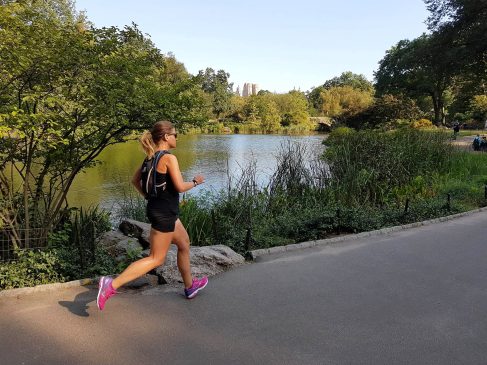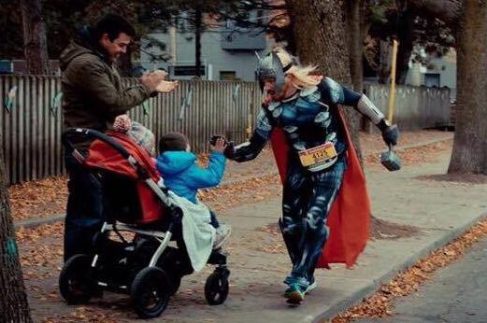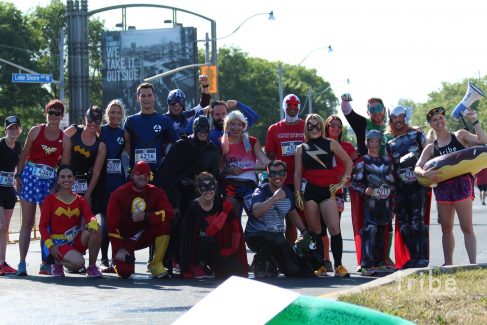Grab Your Shoes and Fly!
Heather Gardner explores the wide open world of destination races.
Your gels are packed, along with a few other of your race day rituals, powdered electrolytes, lucky socks, and unforgettable race hat. Your running gear and traditions have been tried-and-true, but something’s different—this race’s start line is 3,878km away! It’s no longer just about your run, but rather expanding your race experience and many runners are following suit. By travelling the world and living like a local, destination runners get inside what destination race communities have to offer. You and thousands of other Canadian runners are lacing up to take on the world, crush race goals and travel to bucket list destinations. Destination races are booming and traveling runners—including myself—can tell you why.
After returning from my thirteenth destination race in December in Barbados, I know the allure of destination races. Having travelled alone and in large groups, destination races offer runners the obvious subtleties of travelling alongside the thrill of sharing new experiences, accomplishments and bonding with friends. My destination races include: being 1 of 30 runners in a Vancouver race with my run group Tribe, being 1 of 8 runners in a Paris race in 2014 for the Marathon De Paris, and 1 of 4 runners in a Disney World race for the inaugural Dopey Challenge. However my most prized destination race was with my sister in New York City in 2010. The New York City race was our first destination race and our first marathon and really the gateway into the past seven years of endurance sports. The race was a goal I had set for us two years prior, to “race our first marathon, to do it in New York, and to cross the finish line holding hands,” and we did it!
New York City has personal significance to my family. It was my final family trip before the passing of my mum in 2005, and as a runner, it’s one of the world marathon majors known for its epic crowd support and huge participation numbers (51,388 finishers).
I’m not the only one catching the racer’s travel bug. Charlotte Brookes, event director at Canada Running Series shares that, “over 15% of race entries, in adult races, in the 2016 Scotiabank Toronto Waterfront Marathon (STWM) were from participants coming outside of Canada, with USA, Mexico, and Great Britain leading the way. Out of province racers also made the trip, with the highest number of registrants travelling from Quebec, Alberta, and British Columbia.” Brookes attributes this to new tour groups and agency packages. For example, groups such as Canadian Affair for U.K. Runners, Your Group from China, and Your Group from Mexico. Combo destination-race tour packages entice runners to go outside of the box. And of course, since it’s 2017, social media has a way of making the world a smaller place. Movements like Bridge The Gap (BTG) are bringing runners together from across the globe. In 2015, STWM was a goal race of the BTG movement resulting in international registration of runners from more than 70 countries at the starting line.
Grace Egan, culture blogger and artist, will be attending her sixth destination race and second BTG event this spring at the Washington Cherry Blossom 10 Mile Run. Egan defines the BTG movement as “an enormous community of wonderful people who love running, meeting others, and generally not taking life too seriously.” Further explaining that the movement is all about “crew love,” a concept her cynical mind scoffed at until she experienced it herself in 2015 at STWM. “We welcomed hundreds of runners from all over the world,” she says. “People stayed in each other’s homes, ate an absurd amount of pasta, ran 21 or 42 kilometres together, danced, and yes—drank a considerable amount of beer.”
For Egan, destination races are not only an opportunity to connect with the global running community, but are also a way to venture off the beaten city path to new and exciting destinations. Egan says, “Every new place I visit, I try to connect with a running group in the city. It’s especially important to find a safe community if you’re a female solo traveller and the running community is perfect for that. No travel magazine or website can compare to sitting down with people who know their hometown and can tell you where you should go and where to avoid.”
It’s this sense of exploration and global accomplishment that keeps registration from international runners high and city doors open. In 2011, Enigma Research conducted an economic impact study for Canada Running Series that estimated an influx of $33.5 million into Toronto as a result of STWM and the Running Health and Fitness Show.
May Stemshorn, a runner with 50 marathons under her race belt, explains how destination races are a great way to explore the sites of a new city. “Running in a different environment is always a challenge and fun,” the 66-year-old says. “You never know what you’ll learn about yourself and running and it’s a way for you to see a great deal of a new city.” Stemshorn remembers a time in New Orleans when a group of friends (that were not racing) went on a city tour while she and others from their group participated in the race. “Racing the marathon covered everything that they saw on the tour!” Stemshorn says. “Plus, pounding pavement in new countries brings on unique sights and smells—who can resist the sight of an ocean-side palm tree?” Stemshorn advises new destination race participants that during destination races, “the key is not to race, but rather to enjoy yourself because if you go too quickly you’ll miss so much of everything that is new around you.”
Travelling these days can be more challenging with heightened security at airports and the cost of flights and hotels, but alternatives do exist, such as booking early and through designated race hotels, or going through accommodation alternatives such as peer-to-peer online homestay networks like Airbnb.
In preparation for the 2016 Airbnb Brooklyn Half Marathon, Airbnb, the title race sponsor, took a closer look at the impact their peer-to-peer network would have on the host city of Brooklyn. In total, they predicted nearly 12,000 guests would be staying with Airbnb hosts over the half-marathon weekend and an increase of approximately US$8 million in economic activity in Brooklyn would occur. This is broken down with US$6 million going directly to the Airbnb hosts and the remaining US$2 million being spent in the community as guests eat and shop in the local area.
Hosts aren’t the only ones benefiting financially, guests in town for the TCS New York City Marathon are saving an average of $200 per night over a race weekend (Friday to Sunday), and are staying for an average of 5.7 nights.
“Running events all over the world are marquee events for cities where Airbnb can add elastic accommodation capacity to cities and provide unique accommodations for runners,” says Aaron Zifkin, Regional Director, Americas Operations at Airbnb. Meanwhile, destination runners are enjoying the impact of their savings and using the extra cash to spend more time travelling and exploring and creating a greater destination race experience.
As a long-time runner, destination races give me something new and exciting to look forward to. The opportunity to travel for a race makes me feel alive and buzzing, counting down the days where I can dip my toes in new sands, explore foreign roads, see historical landmarks and all while doing one of my favourite things—run. Like myself and many other Canadian runners, Grace Egan shares this passion for a destination race. She says they allow her to connect to different runners all over the world. “I can travel to Lyon or New York, meet new people, run with them, practise languages, learn about their lives, and go for coffee after,” she says.
Her race experiences go beyond running, they involve exploring and being engulfed in the culture and life of the places she travels to. Destination races help runners—new and old—experience a destination at a level beyond any guide book or double decker bus. It’s this global connectedness, sense of community and adventure that continues to grow the destination race scene and global running community. When recommending destination races to a friend, Egan suggests thinking of the race as “an excuse to discover somewhere new”—an excuse, now more than ever, runners are making today.


















 Our Magazine
Our Magazine
